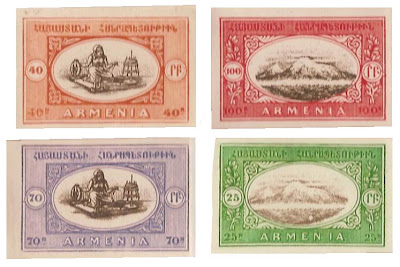
Agri Dagi stamp issued July 17th, 1982 by Turkey.
1921 first set of the Armenian Socialist Republic.(Turkish:Agri Dagi; Armenian: Ararat, Masis; Persian:Koh-i-nuh; Kurdish:Çîyayê Agirî "Fiery Mountain".

As a newly independent nation, Armenia issued three stamps with Ararat imagery on May 28th, 1992.

First Armenian stamp with Ararat imagery [1]since Ararat rises from a flat plain and dominates the skyline of Armenia's capital, Yerevan [2]

[1] Arshak (Archak) Abrahmi Fetvadjian (b. Trabzon Oct. 1, 1866, d. Medford Mass. Oct. 7, 1947) was an Armenian artist and designer. He was an authority on Armenian Architecture. He documented the ruins of Ani, and produced thousands of sketches and watercolor paintings around the turn of the century. His works have been exhibited at the Louvre and at London's Victoria and Albert Museum. He is known for his watercolors and especially for his work in decorating the St. Kevork (Kamoyants) Church and the Monastery of the Virgins (Kusanats) in Tiflis. One of his most famous paintings, "The Woman of Sassoon," depicts a child protected by his mother. The child symbolizes the future Armenia. However he is mostly now remembered for designing the currency and postage stamps for the first Republic of Armenia (1919-1921). The Republic of Armenia fell to a Bolshevik army in 1921 before the stamps could be put in circulation.
[2] Revan of the Ottoman era, captured from Persians in 1635. Hence the Revan pavillion in Topkapi palace and the name given to a desert "Revani".The Erivan (Yerevan) khanate (Persian) was a Muslim controlled principality under the dominion of the Persian Empire between 1747 and 1828. Its territory roughly corresponded to most of present-day central Armenia, most of the Igdir Province of present-day Turkey, and the Sharur and Sadarak rayons of present-day Azerbaijan's province of Nakhichevan. As a result of the Persian defeat in the last Russo-Persian War, it was ceded to the Russian Empire in accordance with the Treaty of Turkmenchay. Immediately following this, the territories of the former Yerevan khanate and the Nakhichevan khanate were joined to form the Armenian oblast and subsequently ethnically cleansed from its majority moslem population.

July 16, 2008
Mavi Boncuk


0 comments:
Post a Comment
Please Update/Correct Any Of The
3700+ Posts by Leaving Your Comments Here
- - - YOUR OPINION Matters To Us - - -
We Promise To Publish Them Even If We May Not Share The Same View
Mind You,
You Would Not Be Allowed Such Freedom In Most Of The Other Sites At All.
You understand that the site content express the author's views, not necessarily those of the site. You also agree that you will not post any material which is false, hateful, threatening, invasive of a person’s privacy, or in violation of any law.
- Please READ the POST FIRST then enter YOUR comment in English by referring to the SPECIFIC POINTS in the post and DO preview your comment for proper grammar /spelling.
-Need to correct the one you have already sent?
please enter a -New Comment- We'll keep the latest version
- Spammers: Your comment will appear here only in your dreams
More . . :
http://armenians-1915.blogspot.com/2007/05/Submit-Your-Article.html
All the best